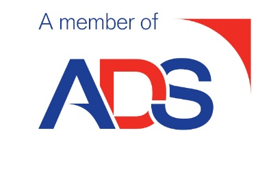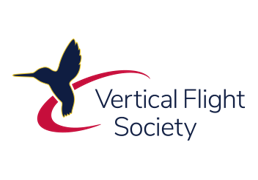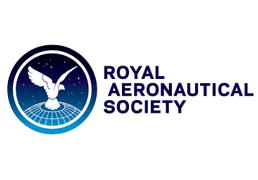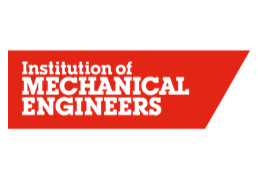Resource Page : Rotorcraft Downwash/Outwash
When a rotorcraft is operated at low enough height above the ground, the aerodynamic interaction with the surface below causes the flow from its rotors to expand out across the ground as a layer of rapidly-moving airflow, called its outwash. If this outwash is strong enough, it can cause significant upset to bystanders and nearby infrastructure.
Dr Brown's work has shown that the shape and strength of the outwash that any multi-rotor eVTOL aircraft will generate is strongly dependent on the layout of its rotors, amongst other factors.
Indeed, several aspects of the behaviour of the outwash that is created by eVTOL aircraft may come as a surprise to the rotorcraft community - where intuition is largely based on experience with conventional helicopters.
The page below contains a set of resources that you might find useful in helping you to understand
- the physical processes that govern the flow in the outwash below a rotorcraft,
- how and when the outwash below a rotorcraft might become a hazard,
- how the design and operation of eVTOL aircraft influences the outwash that they produce, and
- how the outwash from eVTOL aircraft might influence the design and layout of vertiports.
We would be very happy to discuss our work with you. If you would like to talk to us about our research, please feel free either to contact us directly or to access our contact form through the tab below.
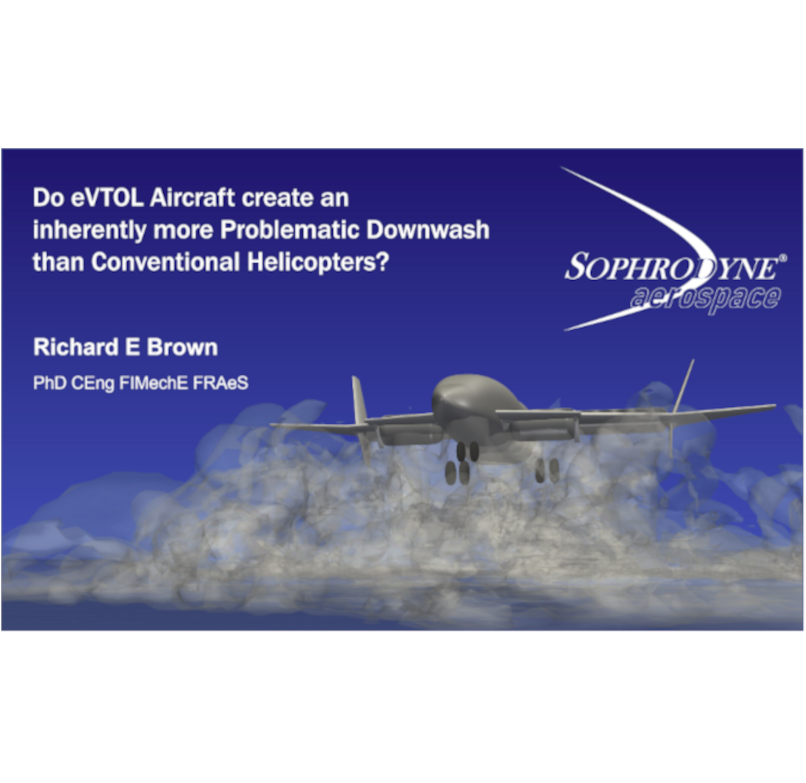
Click on the button below to download a copy of Dr Brown's paper, delivered on 6 September 2023 at
the 49th European Rotorcraft Forum in Bückeburg, Germany.
Extensive worldwide interest in the rotorcraft industry currently exists in developing small, lightweight, electrically-propelled multi-rotor craft, typically capable of carrying four to six passengers on short-range intra-urban missions, for instance as part of a passenger ferry service between an airport and a downtown commuter hub. The potential for the flows generated by helicopter rotors to create significant upset in the vehicle’s surroundings has long been appreciated by the rotorcraft community, yet very little has been written, until recently, about the structure of the downwash field that these new eVTOL aircraft will create, and how this field might interact with the ground during landing and take-off.
A new numerical study suggests that the interactions between the multiple wakes of the rotors of some of these vehicles could amplify and modify key features of the field, especially when it interacts with the ground and turns to outwash. Indeed, the study suggests that the flow out across the ground that is generated by these vehicles could potentially be very different in character and strength to that which is produced by conventional helicopters.
We discuss some of the potential implications of these findings for the developers and operators of these new aircraft, as well as for the designers of the vertiports at which they will begin and end their journeys.
Extensive worldwide interest in the rotorcraft industry currently exists in developing small, lightweight, electrically-propelled multi-rotor craft, typically capable of carrying four to six passengers on short-range intra-urban missions, for instance as part of a passenger ferry service between an airport and a downtown commuter hub. The potential for the flows generated by helicopter rotors to create significant upset in the vehicle’s surroundings has long been appreciated by the rotorcraft community, yet very little has been written, until recently, about the structure of the downwash field that these new eVTOL aircraft will create, and how this field might interact with the ground during landing and take-off.
A new numerical study suggests that the interactions between the multiple wakes of the rotors of some of these vehicles could amplify and modify key features of the field, especially when it interacts with the ground and turns to outwash. Indeed, the study suggests that the flow out across the ground that is generated by these vehicles could potentially be very different in character and strength to that which is produced by conventional helicopters.
We discuss some of the potential implications of these findings for the developers and operators of these new aircraft, as well as for the designers of the vertiports at which they will begin and end their journeys.
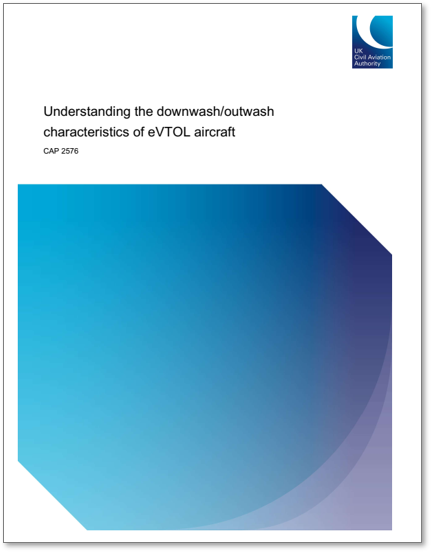
Click on the button below to download a copy of the UK Civil Aviation Authority Publication 2576:
'Understanding the downwash/outwash characteristics of eVTOL aircraft'.
This publication summarises Dr Brown's recent work, funded by the UK Civil Aviation Authority, to understand the properties of the outwash that might be created by eVTOL aircraft and helicopters when they are operated close to the ground.
This publication summarises Dr Brown's recent work, funded by the UK Civil Aviation Authority, to understand the properties of the outwash that might be created by eVTOL aircraft and helicopters when they are operated close to the ground.
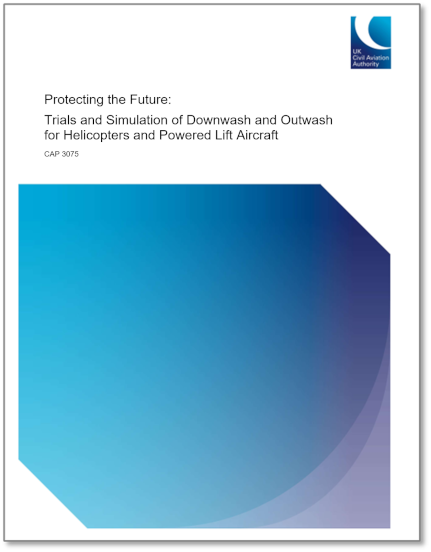
Click on the button below to download a copy of the UK Civil Aviation Authority Publication 3075:
'Protecting the Future: Trials and Simulation of Downwash and Outwash for Helicopters and Powered Lift Aircraft'.
This publication relies extensively on Dr Brown's recent work, funded by the UK Civil Aviation Authority, to understand the properties of the outwash that might be created by eVTOL aircraft and helicopters when they are operated close to the ground.
This publication is supported by a suite of movies that reveal the complexity of the flow in the outwash that is generated below eVTOL aircraft and helicopters when they are operated close to the ground.
This publication relies extensively on Dr Brown's recent work, funded by the UK Civil Aviation Authority, to understand the properties of the outwash that might be created by eVTOL aircraft and helicopters when they are operated close to the ground.
This publication is supported by a suite of movies that reveal the complexity of the flow in the outwash that is generated below eVTOL aircraft and helicopters when they are operated close to the ground.
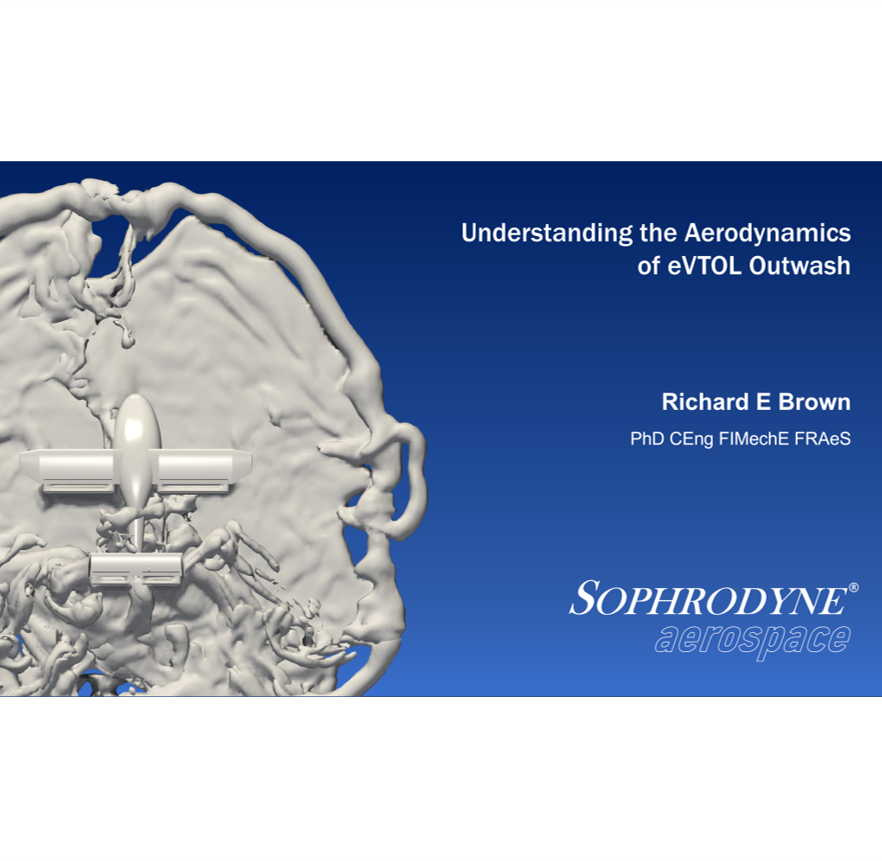
Click on the button below to download a copy of Dr Brown's paper, delivered on 9 September 2025 at
the 51st European Rotorcraft Forum in Venice, Italy.
The flows out across the surface that are produced by eVTOL aircraft when operating close to the ground are very different in character to those produced by the conventional helicopters on which much of our current understanding of rotorcraft outwash is based, yet accurate quantification of the velocities within these flows is seen as an important part of ensuring the safety of this new form of aerial transport.
An analysis of the fundamental fluid mechanics that governs the formation of the flows in the outwash below these aircraft shows the importance of the inherent instability of the vortical structure of the wakes produced by their propulsors in governing both the form and strength of the flow out across the ground below the aircraft. Numerical experiments show the outwash to be particularly susceptible, through the long-term action of this vortical instability, to losing the symmetries that might have been imparted to it by the geometry of the aircraft. This results in flows that in many cases are far more spatially inhomogeneous than might be expected, where the overall characteristics of the flow can vary considerably over time, and, indeed, where the character of the flow might be dependent on the way in which it was formed in the first place.
These observations suggest that we might need to know a great deal more about the physics that governs the aerodynamic behaviour of these systems before we place too much faith in our ability to quantify the risks posed by these aircraft to bystanders and infrastructure that might become exposed to their outwash.
The flows out across the surface that are produced by eVTOL aircraft when operating close to the ground are very different in character to those produced by the conventional helicopters on which much of our current understanding of rotorcraft outwash is based, yet accurate quantification of the velocities within these flows is seen as an important part of ensuring the safety of this new form of aerial transport.
An analysis of the fundamental fluid mechanics that governs the formation of the flows in the outwash below these aircraft shows the importance of the inherent instability of the vortical structure of the wakes produced by their propulsors in governing both the form and strength of the flow out across the ground below the aircraft. Numerical experiments show the outwash to be particularly susceptible, through the long-term action of this vortical instability, to losing the symmetries that might have been imparted to it by the geometry of the aircraft. This results in flows that in many cases are far more spatially inhomogeneous than might be expected, where the overall characteristics of the flow can vary considerably over time, and, indeed, where the character of the flow might be dependent on the way in which it was formed in the first place.
These observations suggest that we might need to know a great deal more about the physics that governs the aerodynamic behaviour of these systems before we place too much faith in our ability to quantify the risks posed by these aircraft to bystanders and infrastructure that might become exposed to their outwash.
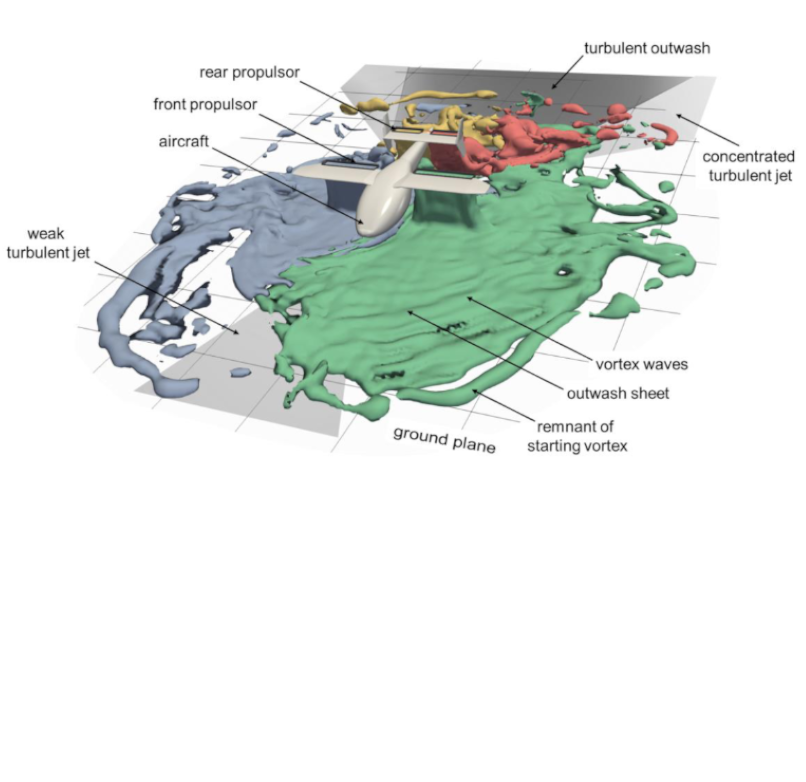
The following presentations of Dr Brown's work on eVTOL outwash are available to watch:
- A recording of the presentation Dr Brown gave in February 2024 to the Vertical Flight Society's eVTOL Flight Test Council, providing an overview of the work contained in CAP2576 (56 minutes long, including questions and discussion).
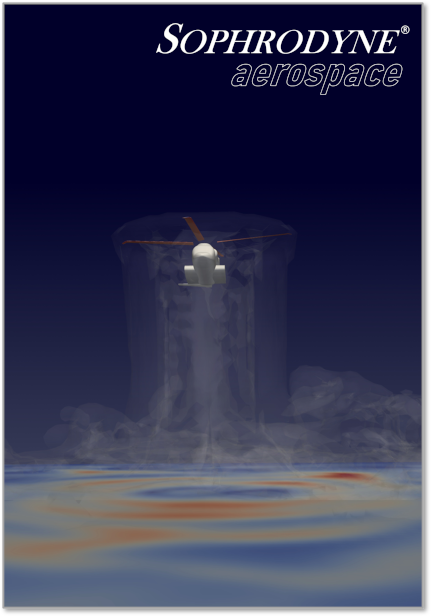
Popular Articles
Dr Brown's work on downwash and outwash has been featured in several articles in the popular aviation press.
Click on the links below to read these articles.
© Sophrodyne Ltd 2015 - 2025


